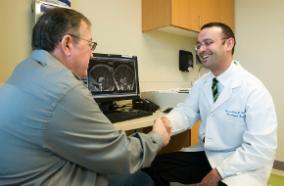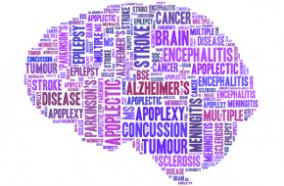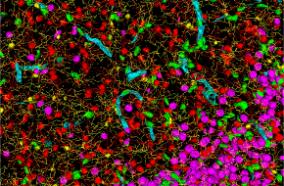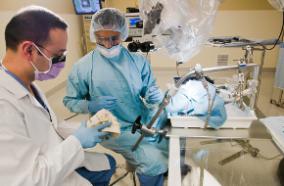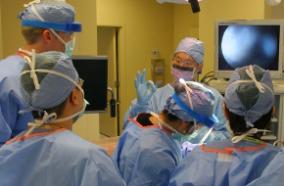1 year 2 months ago
Importation of malaria infections is a suspected driver of sustained malaria prevalence on areas of Bioko Island, Equatorial Guinea. Quantifying the impact of imported infections is difficult because of the dynamic nature of the disease and complexity of designing a randomized trial. We leverage a six-month travel moratorium in and out of Bioko Island during the initial COVID-19 pandemic response to evaluate the contribution of imported infections to malaria prevalence on Bioko Island. Using a...
Dianna E B Hergott
1 year 2 months ago
Mental health conditions and concussion history reported by a collegiate athlete may contribute to prolonged recovery and symptom severity after concussion. This work examined the potential associations among concussion history, preexisting conditions, and sex relative to initial symptom severity and recovery duration following sport-related concussion (SRC) in a cohort of Division 1 National Collegiate Athletic Association athletes. This prospective cohort study analyzed symptom severity,...
Niki A Konstantinides
1 year 2 months ago
CONCLUSIONS: Practically negligible item-level bias was identified across education and ethnicity/language. Detected DIF can be described as benign, indicating that some items manifested differently between groups but had minimal impact on measurement properties. These results demonstrate that the SMCQ performs appropriately across demographic variables. Our findings also provide support for the associations of SMCQ scores with self-reported mood, cognitive status, and AD blood-based biomarkers.
Andrea Pilar Ochoa Lopez
1 year 2 months ago
Swallowing, both nutritive and non-nutritive, is highly dysfunctional in children with Leigh Syndrome (LS) and contributes to the need for both gastrostomy and tracheostomy tube placement. Without these interventions aspiration of food, liquid, and mucus occur resulting in repeated bouts of respiratory infection. No study has investigated whether mouse models of LS, a neurometabolic disorder, exhibit dysfunctions in neuromuscular activity of swallow and breathing integration. We used a genetic...
Alyssa Huff
1 year 2 months ago
Chronic hepatitis B is a global health concern with a high risk of end-stage liver disease. Current standard-of-care agents have low cure rates, and new therapies are needed. Small interfering RNAs (siRNAs) that target viral RNAs fulfill a gap not addressed by standard-of-care agents and may contribute to a functional cure. Here, we describe the preclinical characterization of imdusiran (AB-729), a novel, pan-genotypic siRNA therapeutic that effectively reduces HBsAg, viral antigens, and viral...
Emily P Thi
1 year 2 months ago
No abstract
Margaret McGrath
1 year 2 months ago
CONCLUSIONS: Early conversion to an alternative EVT technique after a failed first pass recanalization in patients with AIS is associated with better technical success and clinical outcomes.
Hidetoshi Matsukawa
1 year 2 months ago
Traumatic spinal cord injury (tSCI) causes an immediate loss of neurological function, and the prediction of recovery is difficult in the acute phase. In this study, we used contrast-enhanced ultrasound imaging to quantify intraspinal vascular disruption acutely after tSCI. In a rodent thoracic tSCI model, contrast-enhanced ultrasound revealed a perfusion area deficit that was positively correlated with injury severity and negatively correlated with hindlimb locomotor function at 8 weeks after...
Zin Z Khaing
1 year 2 months ago
CONCLUSION: Among patients with anterior circulation large vessel occlusion and low ASPECTS, MT seems to provide a similar benefit to functional outcome for patients presenting <6 hours or 6 to 24 hours after onset.
Sameh Samir Elawady
1 year 2 months ago
CONCLUSIONS: LP-WGS of CSF-derived cfDNA is feasible using a clinical platform, with greater sensitivity for tumor detection compared to conventional CSF cytologic analysis at initial staging. Large prospective studies are needed to further evaluate LP-WGS as a predictive biomarker.
Erin E Crotty
1 year 2 months ago
Post-traumatic epilepsy (PTE) is a recurrent and often drug-refractory seizure disorder caused by traumatic brain injury (TBI). No single drug treatment prevents PTE, but preventive drug combinations that may prophylax against PTE have not been studied. Based on a systematic evaluation of rationally chosen drug combinations in the intrahippocampal kainate (IHK) mouse model of acquired epilepsy, we identified two multi-targeted drug cocktails that exert strong antiepileptogenic effects. The...
Mustafa Q Hameed
1 year 2 months ago
No abstract
Michael R Levitt
1 year 2 months ago
Understanding of newborn immune ontogeny in the first week of life will enable age-appropriate strategies for safeguarding vulnerable newborns against infectious diseases. Here we conducted an observational study exploring the immunological profile of infants longitudinally throughout their first week of life. Our Expanded Program on Immunization - Human Immunology Project Consortium (EPIC-HIPC) studies the epigenetic regulation of systemic immunity using small volumes of peripheral blood...
David Martino
1 year 2 months ago
Program death 1 (PD-1) inhibitors such as nivolumab are immune checkpoint inhibitors that have revolutionized the treatment of metastatic melanoma. Despite its success in treating melanoma, immune activation can lead to immune-related adverse effects, which are experienced by half of melanoma patients treated with PD-1 inhibitors. Despite the common frequency of immune-mediated adverse events, the development of a secondary lymphoma is exceedingly rare. We present the case of a 53-year-old woman...
Tommy Y Yu
1 year 2 months ago
Cutaneous mycobacterial infections cause substantial morbidity and are challenging to diagnose and treat. An improved understanding of the dermal immune response to mycobacteria may inspire new therapeutic approaches. We conducted a controlled human infection study with 10 participants who received 2 × 106 CFUs of Mycobacterium bovis bacillus Calmette-Guérin (Tice strain) intradermally and were randomized to receive isoniazid or no treatment. Peripheral blood was collected at multiple time...
E Chandler Church
1 year 2 months ago
CONCLUSIONS: These observations highlight the capacity of omental adipocytes to generate a pro-tumorigenic and chemoprotective microenvironment in ovarian cancer and other adipose-related malignancies.
Michael Ellis Williams
1 year 2 months ago
CONCLUSIONS: Assessment of gross motor function reflected a consistent pattern of significantly slower performances for blast and nonblast TBI groups compared to controls, over all follow-up intervals. Fine motor function performance reflected a similar significant difference pattern at 1- and 5-year follow-up intervals, with a reduced difference from control groups at the 10-year follow-up. Maintenance of high-level motor functions, including overall motor speed, coordination, and reaction...
David Coppel
1 year 2 months ago
With the development and characterization of biomarkers that may reflect neural network state as well as a patient's clinical deficits, there is growing interest in more complex stimulation designs. While current implantable neuromodulation systems offer pathways to expand the design and application of adaptive stimulation paradigms, technological drawbacks of these systems limit adaptive neuromodulation exploration. In this paper, we discuss the implementation of a phase-triggered stimulation...
Hanbin Cho
1 year 2 months ago
Traumatic brain injury (TBI), a global leading cause of mortality and disability, lacks effective treatments to enhance recovery. Synaptic remodeling has been postulated as one mechanism that influences outcomes after TBI. We sought to investigate whether common mechanisms affecting synapse maintenance are shared between TBI and other neuropsychiatric conditions using pathway enrichment tools and genome-wide genotype data, with the goal of highlighting novel treatment targets. We leveraged an...
Savvina Prapiadou
1 year 2 months ago
CONCLUSIONS: IVT is associated with improved functional outcomes in AIS patients with LVO despite unsuccessful MT.
Sameh Samir Elawady
"university of washington"[affiliation] and neurological surge...: Latest results from PubMed
More posts about UW Neurological Surgery Recent PubMed Publications

